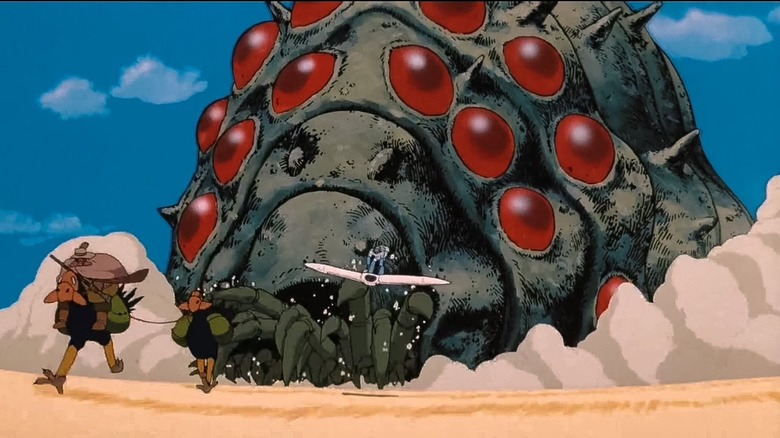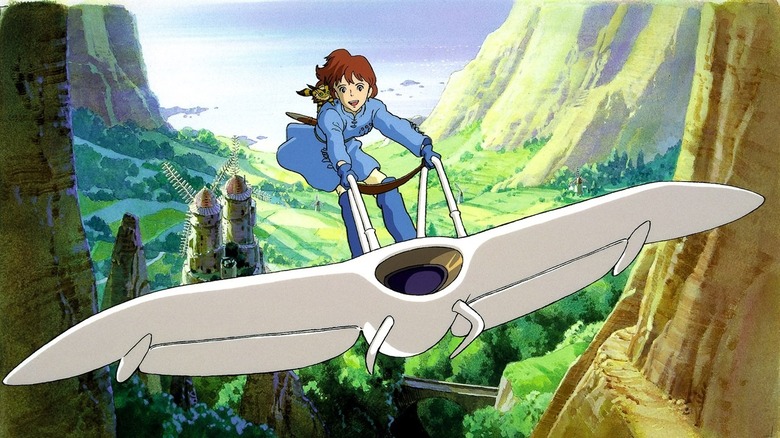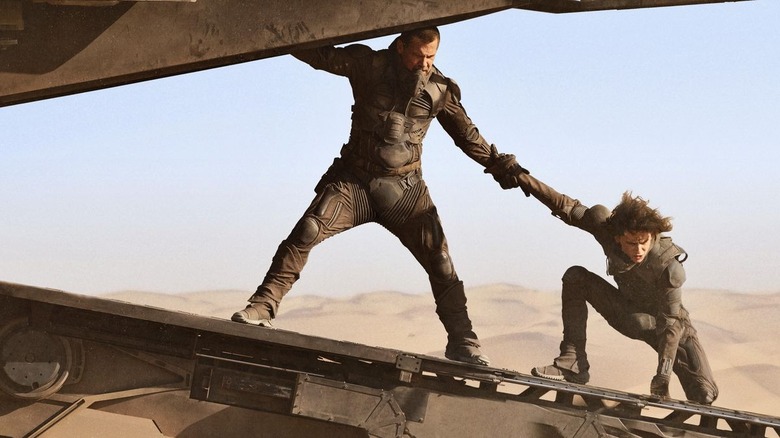If You Want To Prep For Dune, Watch Nausicaa Of The Valley Of The Wind
A desert planet. A prophesied messiah. A tyrannical empire. Giant bugs.
You may think I'm describing "Dune," the new sci-fi epic directed by Denis Villeneuve. Or your mind might even go to "Star Wars," itself a beloved sci-fi saga inspired by the 1965 novel by Frank Herbert. But the above also applies to "Nausicaa of the Valley of the Wind," the masterful 1984 animated film written and directed by Hayao Miyazaki.
Set in a future post-apocalyptic world where a devastating war has reduced the Earth into barren wastelands and toxic forests, "Nausicaa of the Valley of the Wind" follows the titular young warrior as she tries to prevent warring kingdoms from destroying the mutant giant insects that live within the uninhabitable jungles.
Though Miyazaki has never explicitly cited "Dune" as one of the inspirations for "Nausicaa" — other Western genre classics like Ursula K. Le Guin's "Earthsea," Brian Aldiss's "Hothouse," Isaac Asimov's "Nightfall," and J. R. R. Tolkien's "The Lord of the Rings" have been mentioned by the anime auteur — the parallels are obvious. Both, after all, are a messiah story set on a barren planet in which humans live uncomfortably alongside giant insects that may attack them at a moment's notice. It's what makes "Nausicaa" the perfect movie to watch ahead of the release of Villeneuve's "Dune," perhaps even more so than David Lynch's infamous 1984 adaptation.
Nausicaa is the Perfect Companion Watch to Dune
Nausicaa is a warrior princess of the small kingdom of the Valley of the Wind, which borders the Toxic Jungle, the poisonous forests that were a remnant of the devastating ancient wars and that harbor giant, deadly insects known as the Ohmu. Just stepping into the forests is toxic to humans thanks to the poisonous spores in the air and the thousands of angry mutant insects, but Nausicaa has found a way to communicate with the creatures that suggests she is the long-prophesied savior of the world.
But an invading kingdom seeks to use an ancient weapon to eradicate the jungle and destroy the Ohmu in the process. What they don't realize, and what Nausicaa has discovered, is that the Ohmu are a crucial part of the ecosystem, and that the toxic forests are actually the Earth's way of cleansing the centuries of human devastation.
Like "Nausicaa," "Dune" centers on a would-be messiah (in the case of the upcoming Villeneuve film, Timothée Chalamet's Paul Atreides) who learns to tame the enormous sandworms that inhabit the desert planet of Arrakis, and who are revealed to play a pivotal part in the creation of that precious resource known as the "spice" mélange, which the ruling Imperium has harnessed to fold space. While Herbert's story is set in a distant future where humanity has expanded throughout the galaxy and spans planets, it also heavily features an invading imperial force whom Paul must fight with the help of the native Fremen of Arrakis. And if we're going to include more visual similarities, in Villeneuve's "Dune," the insect-like helicopters they fly even look similar to the ones in "Nausicaa."
The Spirit of Dune
At face value, "Nausicaa" is not exactly beat-for-beat the plot of Herbert's vastly more dense "Dune" saga. Rather than sprawling centuries with thousands lost to bloodshed, Miyazaki's film takes place on a single planet and ends on a more hopeful note, with a messiah whose compassion manages to bring an end to the genocide. (Though if you get into the original graphic novels that Miyazaki wrote before his feature film, "Nausicaa" rivals "Dune" in complexity and grim overtures.) While the messiah narrative figures heavily into "Part One" of "Dune," and (hopefully) its sequel, "Dune" doesn't necessarily offer such easy answers. (But again, read Miyazaki's much darker, thornier graphic novels to get a sense of how "Nausicaa" doesn't either.)
Perhaps the largest difference between the two is that "Nausicaa" is primarily an ecological sci-fi tale compared to the economic sci-fi saga of "Dune," which charts the rise and fall of empires via the revolts of the oppressed over a precious resource. As is the case with all Miyazaki films, "Nausicaa" is much more interested in what destruction humanity has wrought on the Earth than the destruction they wreak upon themselves.
"Dune" remains the most daunting "blockbuster" franchises. Several filmmakers have tried and failed to bring Frank Herbert's vision to the big screen, including Alejandro Jodorowsky and David Lynch. But instead of looking to slavishly bring Herbert's vision to life, perhaps they should have looked overseas to Japan, where Miyazaki had already brought the spirit of "Dune" to the screen with "Nausicaa of the Valley of the Wind."
"Nausicaa of the Valley of the Wind" is now streaming on HBO Max.


